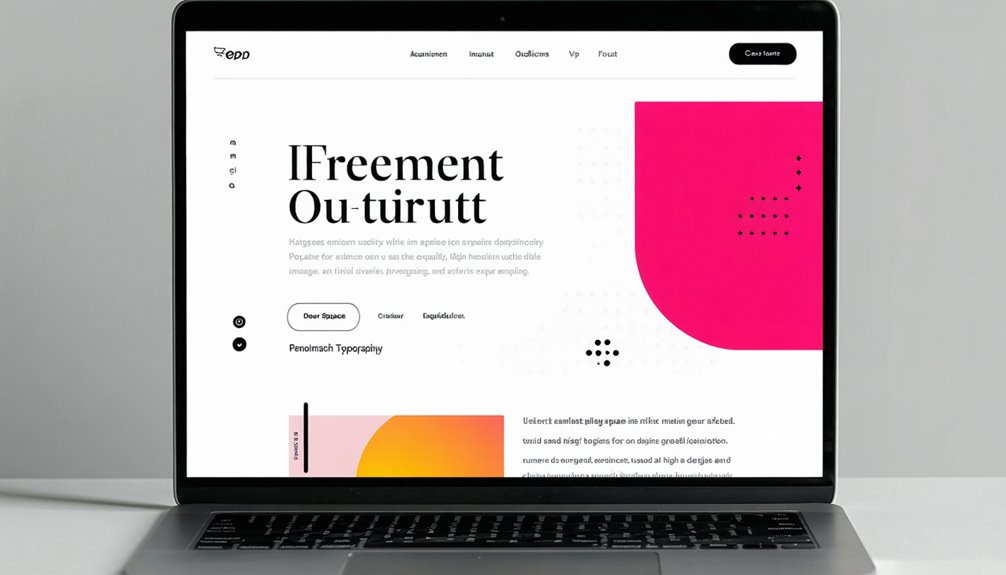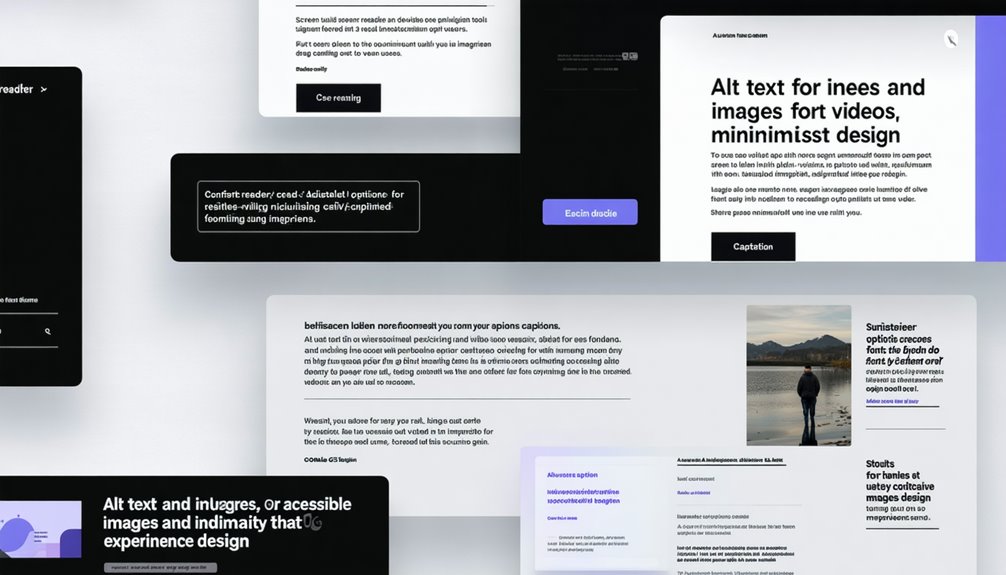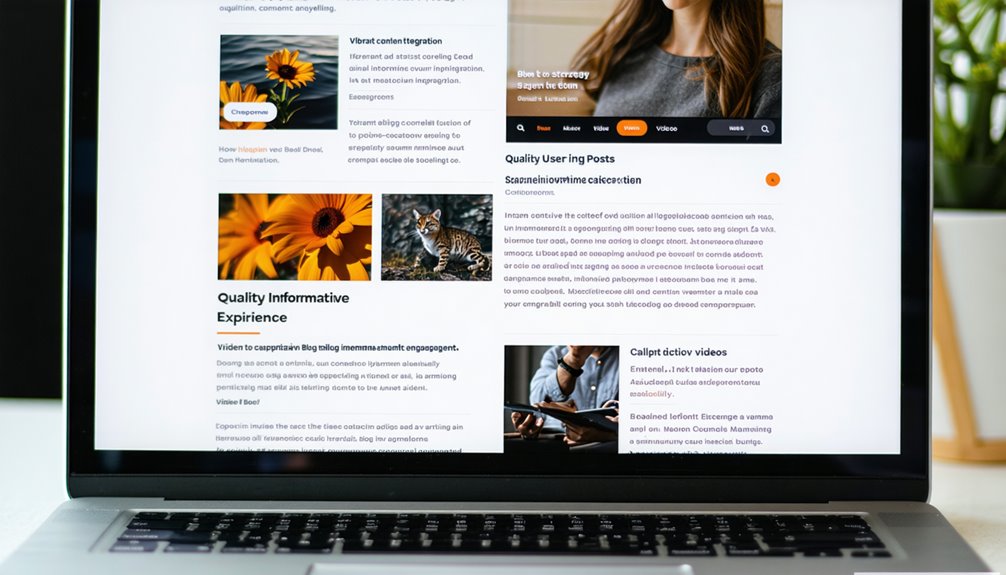Great website designs stand out by incorporating key design principles like minimalism, clear navigation, and strategic content placement. Engaging visual elements such as color schemes aligned with brand identity, high-quality imagery, and consistent typography enhance user engagement. Prioritizing web accessibility through features like alt text and logical headings caters to all users, boosting inclusivity and brand loyalty. Functional aspects like user-friendly navigation, prominent call-to-action buttons, and social proof contribute to a seamless user experience. Quality content strategies, SEO best practices, and performance optimization further elevate the website's effectiveness. Implementing these strategies collectively distinguishes exceptional website designs.
Design Principles and Elements

Great Website Designs encompass a harmonious integration of Design Principles and Elements that collectively contribute to an exceptional user experience.
When it comes to website design, web page designers near me prioritize homepage minimalism to guarantee core messages are instantly communicated without clutter. Important content is strategically placed above the fold for immediate visibility, enhancing user engagement.
Visual hierarchy is essential, guiding user attention to key components through strategic placement, size, and color contrast, ultimately improving readability. A well-structured navigation system is also key, allowing for easy content discovery with clear categories and a logical flow that encourages exploration.
Typography, with body text set to a minimum size of 16pt and limited to three typefaces, impacts readability and user experience considerably.
Additionally, color theory plays an essential role in web design, as cohesive color schemes can evoke emotions, improve readability, and reinforce brand identity, influencing user interaction in a profound way.
Engaging Visual Elements
Engaging Visual Elements are vital components in website design, enchanting visitors and enhancing user experience through strategic integration of colors, typography, and imagery.
Colors are essential in evoking emotions and attracting attention, with palettes aligned to brand identity enhancing website appeal. Typography plays a significant role in readability, where sans serif fonts are preferred for body text.
Consistent color schemes reinforce brand identity and improve user engagement by providing a cohesive visual experience. Visual hierarchy, determined by the size, weight, and placement of elements, guides user attention effectively.
High-quality imagery, such as authentic photography and engaging videos, can boost user retention by creating visually appealing experiences.
In custom ecommerce website development, these elements are vital for creating visually appealing and user-friendly web design websites that stand out and leave a lasting impression on visitors.
Web Accessibility

Ensuring web accessibility is a fundamental aspect of website design, facilitating equal access and usability for individuals with disabilities. Website designers and developers play an essential role in creating inclusive online experiences that comply with standards like the Web Content Accessibility Guidelines (WCAG).
Approximately 15% of the global population faces some form of disability, underscoring the importance of accessible web design in reaching a broader audience and promoting web branding.
Incorporating features such as alt text for images, logical heading structures, and captions for media can greatly enhance the browsing experience for users with visual or hearing impairments. Regular accessibility testing, including feedback from individuals with disabilities, is critical for identifying and addressing potential usability barriers.
Accessible websites not only meet legal requirements but also elevate user experience, driving increased engagement, customer loyalty, and fostering a positive brand image. Prioritizing web accessibility not only broadens audience reach but also aligns with the principles of inclusivity and user-centric design.
Functionality and Features
In the domain of website design, the focus shifts towards the significant aspect of functionality and features. Websites should clearly outline their objectives and goals to tailor the design and development process to meet specific user needs effectively.
Fundamental features like user-friendly navigation menus and prominent call-to-action buttons play an essential role in enhancing usability and encouraging user engagement. Incorporating social proof through testimonials and case studies builds trust and credibility, influencing user decisions and conversions considerably.
A well-structured website with a logical heading hierarchy and intuitive layout guarantees that users can find information and navigate content seamlessly. Regular performance testing and updates are critical to ensure all functionalities work correctly, improving the user experience and maintaining site reliability.
When looking for high-quality website design websites, consider reaching out to web developers near me for expert assistance and guidance.
Quality Content Strategy

A fundamental element essential to the success of any website lies in the implementation of a quality content strategy. High-quality content, characterized by clarity, conciseness, and relevance, plays a vital role in engaging visitors and fostering repeat visits, thereby enhancing user retention and satisfaction.
Regular updates not only keep the website fresh but also boost search engine rankings, with increased visibility for sites posting new content weekly.
Integrating diverse content formats like images, videos, and infographics enriches the user experience, enhancing information digestibility and engagement. This, in turn, can increase the time visitors spend on the site.
A well-defined content strategy that aligns with target audience preferences can lead to a 72% increase in engagement rates, driving higher conversion rates and brand loyalty. Additionally, consistent messaging and storytelling across all content types reinforce brand identity, establishing credibility and facilitating stronger connections with the brand and its values in the area of web design.
SEO Best Practices
To maximize a website's visibility and reach, understanding and implementing SEO best practices are paramount.
Conducting thorough keyword research is essential, as 75% of users never venture past the first search results page. Targeting relevant keywords enhances visibility.
Optimizing on-page SEO elements like title tags and meta descriptions can boost click-through rates by up to 30% and improve search engine rankings.
Quality backlinks are critical for SEO success, as websites with authoritative backlinks tend to rank better.
Updating website content regularly can lead to a 434% increase in indexed pages, greatly elevating organic traffic.
Implementing structured data markup aids search engines in comprehending website content, potentially increasing visibility in search engine results through rich snippets and boosting click-through rates.
Incorporating these SEO best practices into web design can markedly enhance a website's performance and visibility.
Performance Optimization

Achieving ideal performance for a website is fundamental in ensuring a seamless user experience and maximizing engagement. Fast loading times play a critical role in this aspect, as studies have shown that even a one-second delay can result in a 7% reduction in conversions and an 11% increase in page views.
Image optimization is key to improving site speed by up to 80%, enhancing user experience considerably. Additionally, minimizing code and scripts, such as removing unnecessary whitespace and comments, can reduce page load times and enhance overall performance.
Regular performance testing using tools like Google PageSpeed Insights is essential for identifying bottlenecks and obtaining actionable recommendations to boost site speed. It is crucial to recognize that user experience is directly linked to site performance, with a well-optimized website capable of reducing bounce rates by up to 50%, keeping users engaged and increasing conversion potential.
When considering website designs, performance optimization should be a top priority for any website designer near me.
Frequently Asked Questions
What Makes a Website Design Good?
A good website design encompasses intuitive navigation, fast loading times, consistent visual elements, high-quality content, mobile responsiveness, and effective call-to-action buttons. These elements collectively enhance user experience, brand identity, customer loyalty, SEO, and conversion rates.
What Makes a Website Stand Out?
A website stands out when it effectively combines cohesive branding elements, engaging visuals, intuitive navigation, mobile responsiveness, and strategic calls-to-action. This harmonious blend not only captures attention but also enhances user experience, drives conversions, and builds brand recognition successfully.
What Are the Five Golden Rules of Web Designing?
The five golden rules of web designing are prioritizing clarity and simplicity, implementing responsive design, ensuring intuitive navigation, establishing a strong visual hierarchy, and maintaining consistency in visual identity. These principles enhance user experience and foster brand credibility.
What Are the Qualities of a Great Website?
A great website features intuitive navigation, high-quality visuals, cohesive color schemes, responsive design, effective use of whitespace and visual hierarchy, and quality, regularly updated content. These qualities enhance brand identity, user engagement, readability, and SEO performance.
Conclusion
To sum up, great website designs stand out by incorporating key design principles and elements, engaging visual elements, web accessibility, functionality and features, quality content strategy, SEO best practices, and performance optimization. These elements work together to create a seamless user experience and drive traffic to the site. By prioritizing these aspects, websites can effectively capture and retain the attention of their audience, ultimately leading to increased engagement and success.




0 Comments